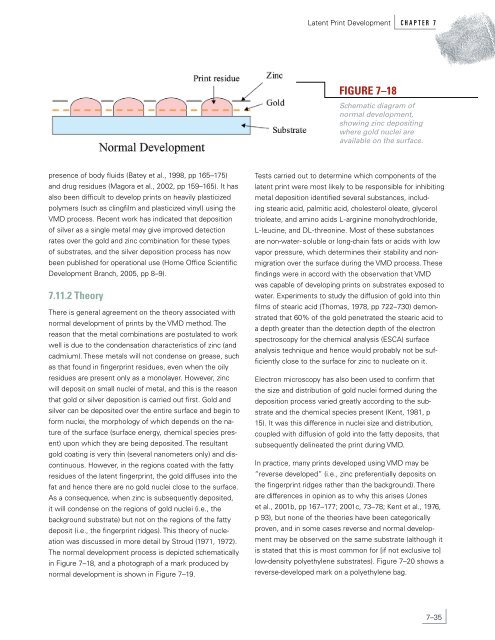Latent Print Development - National Criminal Justice Reference ...
Latent Print Development - National Criminal Justice Reference ...
Latent Print Development - National Criminal Justice Reference ...
You also want an ePaper? Increase the reach of your titles
YUMPU automatically turns print PDFs into web optimized ePapers that Google loves.
presence of body fluids (Batey et al., 1998, pp 165–175)<br />
and drug residues (Magora et al., 2002, pp 159–165). It has<br />
also been difficult to develop prints on heavily plasticized<br />
polymers (such as clingfilm and plasticized vinyl) using the<br />
VMD process. Recent work has indicated that deposition<br />
of silver as a single metal may give improved detection<br />
rates over the gold and zinc combination for these types<br />
of substrates, and the silver deposition process has now<br />
been published for operational use (Home Office Scientific<br />
<strong>Development</strong> Branch, 2005, pp 8–9).<br />
7.11.2 Theory<br />
There is general agreement on the theory associated with<br />
normal development of prints by the VMD method. The<br />
reason that the metal combinations are postulated to work<br />
well is due to the condensation characteristics of zinc (and<br />
cadmium). These metals will not condense on grease, such<br />
as that found in fingerprint residues, even when the oily<br />
residues are present only as a monolayer. However, zinc<br />
will deposit on small nuclei of metal, and this is the reason<br />
that gold or silver deposition is carried out first. Gold and<br />
silver can be deposited over the entire surface and begin to<br />
form nuclei, the morphology of which depends on the nature<br />
of the surface (surface energy, chemical species present)<br />
upon which they are being deposited. The resultant<br />
gold coating is very thin (several nanometers only) and discontinuous.<br />
However, in the regions coated with the fatty<br />
residues of the latent fingerprint, the gold diffuses into the<br />
fat and hence there are no gold nuclei close to the surface.<br />
As a consequence, when zinc is subsequently deposited,<br />
it will condense on the regions of gold nuclei (i.e., the<br />
background substrate) but not on the regions of the fatty<br />
deposit (i.e., the fingerprint ridges). This theory of nucleation<br />
was discussed in more detail by Stroud (1971, 1972).<br />
The normal development process is depicted schematically<br />
in Figure 7–18, and a photograph of a mark produced by<br />
normal development is shown in Figure 7–19.<br />
<strong>Latent</strong> <strong>Print</strong> <strong>Development</strong> C H A P T E R 7<br />
FIGURE 7–18<br />
Schematic diagram of<br />
normal development,<br />
showing zinc depositing<br />
where gold nuclei are<br />
available on the surface.<br />
Tests carried out to determine which components of the<br />
latent print were most likely to be responsible for inhibiting<br />
metal deposition identified several substances, including<br />
stearic acid, palmitic acid, cholesterol oleate, glycerol<br />
trioleate, and amino acids L - arginine monohydrochloride,<br />
L - leucine, and DL - threonine. Most of these substances<br />
are non-water- soluble or long-chain fats or acids with low<br />
vapor pressure, which determines their stability and nonmigration<br />
over the surface during the VMD process. These<br />
findings were in accord with the observation that VMD<br />
was capable of developing prints on substrates exposed to<br />
water. Experiments to study the diffusion of gold into thin<br />
films of stearic acid (Thomas, 1978, pp 722–730) demonstrated<br />
that 60% of the gold penetrated the stearic acid to<br />
a depth greater than the detection depth of the electron<br />
spectroscopy for the chemical analysis (ESCA) surface<br />
analysis technique and hence would probably not be sufficiently<br />
close to the surface for zinc to nucleate on it.<br />
Electron microscopy has also been used to confirm that<br />
the size and distribution of gold nuclei formed during the<br />
deposition process varied greatly according to the substrate<br />
and the chemical species present (Kent, 1981, p<br />
15). It was this difference in nuclei size and distribution,<br />
coupled with diffusion of gold into the fatty deposits, that<br />
subsequently delineated the print during VMD.<br />
In practice, many prints developed using VMD may be<br />
“reverse developed” (i.e., zinc preferentially deposits on<br />
the fingerprint ridges rather than the background). There<br />
are differences in opinion as to why this arises (Jones<br />
et al., 2001b, pp 167–177; 2001c, 73–78; Kent et al., 1976,<br />
p 93), but none of the theories have been categorically<br />
proven, and in some cases reverse and normal development<br />
may be observed on the same substrate (although it<br />
is stated that this is most common for [if not exclusive to]<br />
low-density polyethylene substrates). Figure 7–20 shows a<br />
reverse-developed mark on a polyethylene bag.<br />
7–35

















